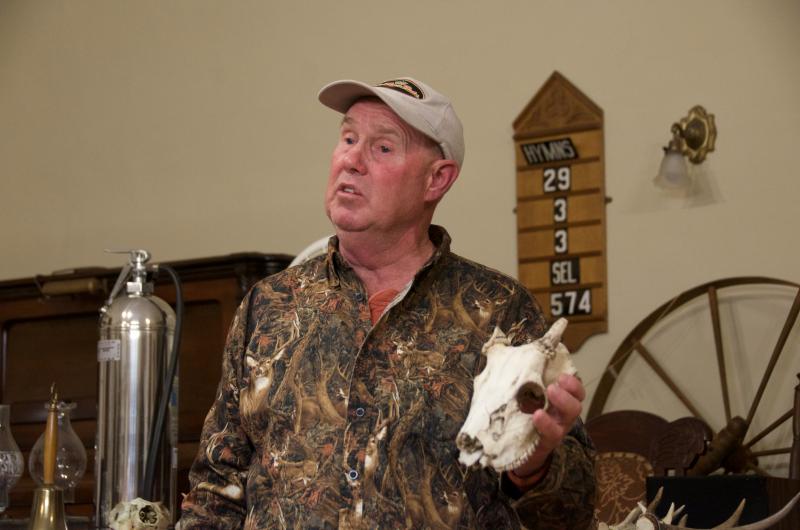Oh deer! Brothers make antler hunting a hobby
Looking for deer antlers in the woods takes patience and a geriatric pace.
“If somebody with a walker can’t pass you, you’re going too fast,” says David Lawrence.
David, his brother Gifford and a number of their friends are committed shed hunters, the in-the-know term for finding antlers left behind by members of the deer family.
And they get pretty excited whenever they find one. David admits to doing a “happy dance” whenever he finds an antler, be it an intact specimen or a piece gnawed on by mice and squirrels.
“They’re like a prize to us and we love finding them,” said Gifford, who goes by Gif.
The camouflaged Rochester-natives spoke about their frequent hunting expeditions at the Rochester Historical Society on March 16, offering up interesting facts, amusing stories and pointers for finding antlers.
Bucks alone have antlers, which can grow at fast as three-quarters of an inch a day for some species, said Gif. Bucks use their antlers to attract does, mark their territory and fight, with the color changing over time to help the animals blend into their surroundings as the seasons change. But when winter comes, the antlers come off, and that’s when the Lawrence brothers start hunting.
They go into “tight woods,” looking for the antlers, which could be stuck in briars, under the snow or tines down. Finding buck droppings, which David said look like Junior Mints (as opposed to doe dropping that resemble Cocoa Puffs), is often a good place to put your head down and look.
Shed hunters want to find “the Junior Mint trail,” said David.
When on the search, he has crawled 25 yards through prickly vines and stood waist deep in a red maple swamp.
“You don’t know how many May flies we’ve eaten,” he said.
Even when one of the men does find an antler, that doesn’t mean its twin is nearby.
“They’re just like leaves on a tree, they don’t drop at the same time,” said Gif.
Bogs are good places to find the antlers, said the brothers, probably because the deer jump across the ditches knocking off the already loose antlers like a kid’s tooth and a piece of candy.
The prize is definitely to find a matching set. When one of the men does find an antler, he texts the others to come help him look for the other half (after the happy dance, of course).
David’s strategy is to tie a streamer to the tree nearest the find and then make concentric circles, five feet, 10 feet, 80 yards around the discovery site. It’s a slow process and often turns up nothing except ticks and scratches, not that the brothers seem to mind.
They’re dedicated to finding the antlers.
While shed hunting with his wife one day, David saw an antler beside a log she was about to cross.
“I shoved her down on the ground so she couldn’t get to it before I did,” he said, laughing.
David is definitely the more hardcore hunter, though Gif was the one who first began looking for antlers. David can often be found in the woods with his backpack of supplies that includes water to stay hydrated, tape to stick it to the ticks and a compass to get him back to his truck.
He often goes out for hours every day from January to May, and he even bought a pedometer last year to log his miles.
Despite almost 250 miles of hunting in 2015, 20 of which were on snowshoes, the combination of record-breaking snowfall and food scarcity left him with only three antlers, all broken pieces.
“But,” David said, “I spent a lot of time in the woods, had a lot of fun, got some exercise.”
The time spent in the woods makes finding the antlers all the sweeter.
“They’re like snowflakes,” said Gif, no two are the same, even those from the same animal.
David said he hangs his on the crossbeams in one room of his house and has added beams between the beams to accommodate his growing collection
Every night, he said, “I look at ‘em for at least an hour. They’re beautiful to me.”

















